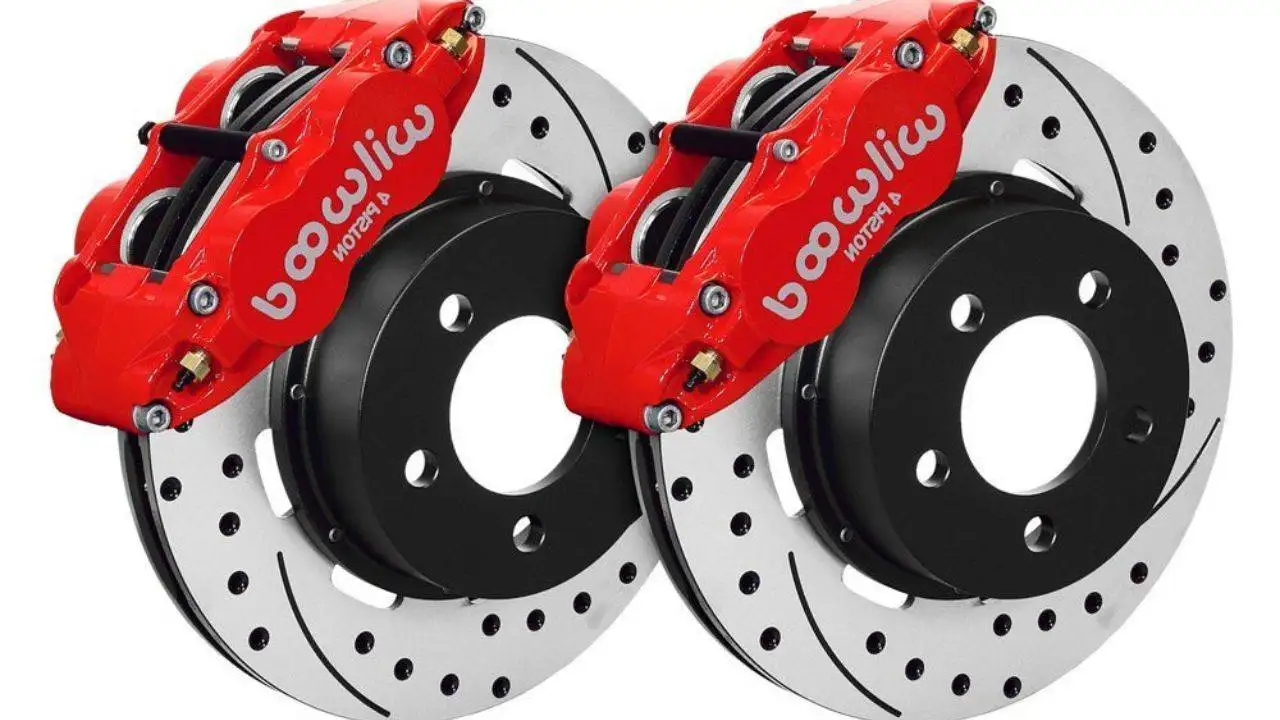Does your vehicle’s braking performance concern you? Deciding between drilled and slotted rotors can be complex and confusing. But don’t worry—we’re here to demystify the question, ‘Are drilled and slotted rotors better?’ We’ll guide you through the selection process for the best option for your car. Prepare yourself for an educational voyage that will help you understand the construction, advantages, uses, and upkeep.
Brief Overview
- Drilled and slotted rotors enhance braking performance, dissipate heat efficiently, reduce wear, and minimize noise.
- Investing in high-quality drilled/slotted rotors is crucial to preventing cracking. Regular cleaning and inspection are also essential for upkeep.
- When choosing the right rotor for your vehicle, it’s valuable to heed expert advice and take into account user feedback and experiences.
What Do Slotted and Drilled Rotors Do?
Before delving in, let’s examine the composition of your stock brakes. Typically, OEM brakes feature smooth rotors with multiple cooling vanes nestled between two smooth surfaces. Plain rotors are the most economical and straightforward to produce. They offer a user-friendly pedal feel with minimal noise and vibration, making them ideal for everyday street cars.
But for those of us who seek more than the ordinary, who value enhanced braking even if it means a bit of squeaking, there’s good news. By switching to performance brake rotors and compatible brake pads, significant braking improvements can be achieved without the hassle of replacing factory brake calipers. Upgrading rotors and pads is as simple as routine stock part replacement!
There are various upgrades available, but the primary choices for performance brake rotors are slotted or drilled. Slotted rotors feature grooves machined into the surface to disperse heat and gases, while drilled rotors boast holes penetrating the friction surface and reaching the cooling vanes within the rotor for the same purpose. Both types enhance braking performance and mitigate brake fade. The decision between them hinges on personal preference and the specific needs and usage of your vehicle.
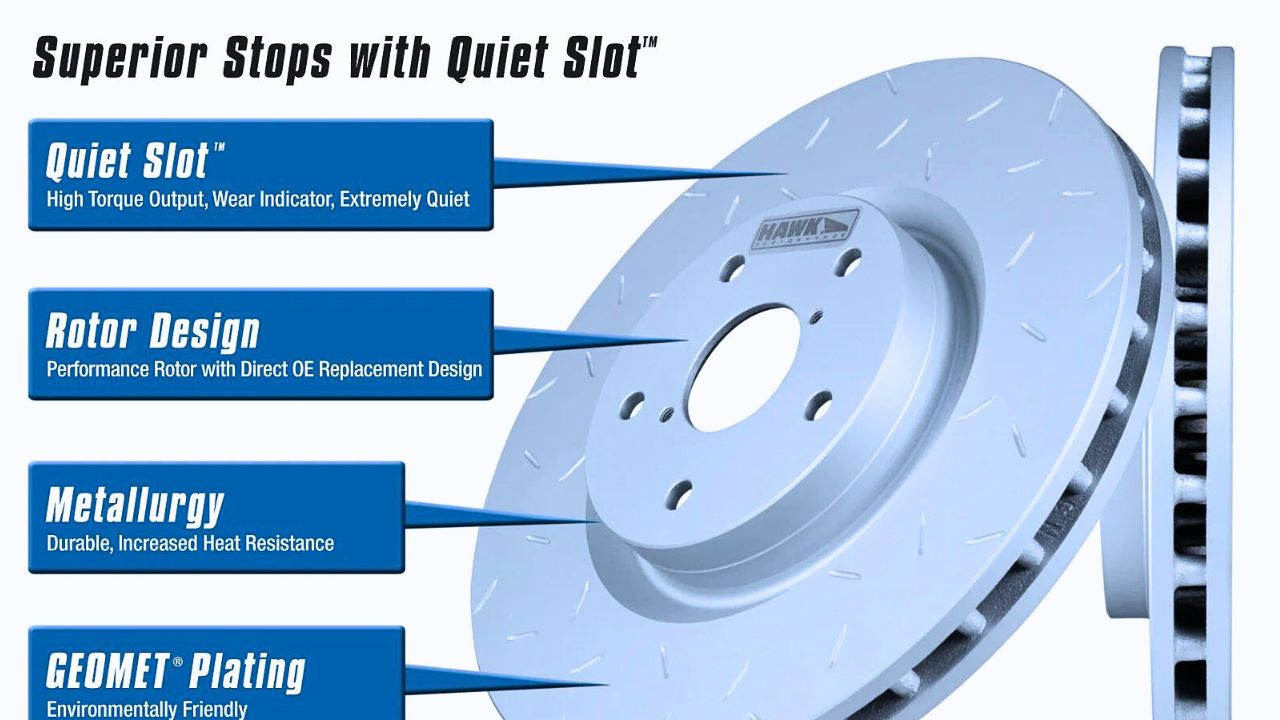
Difference Between Drilled and Slotted Rotors
Brake rotors play a critical role in a vehicle’s braking system, providing the necessary friction to slow down or stop a moving vehicle. Among the various types of rotors available in the market, drilled and slotted rotors stand out as popular choices. But what sets them apart, and how do they influence braking performance? Let’s delve into the nuances to understand their differences and determine which might be the better option for your vehicle.
Drilled Rotors Comprehension
As the name suggests, drilled rotors feature holes drilled into their surface. These holes serve multiple purposes, including dissipating heat generated during braking and allowing gases to escape, thereby preventing brake fade. Additionally, the holes aid in water dispersion, enhancing braking performance in wet conditions.
Pros of Drilled Rotors:
- Improved heat dissipation.
- Reduced risk of brake fade.
- Enhanced wet weather performance.
Cons of Drilled Rotors:
- Increased risk of stress fractures.
- Potentially shorter lifespan compared to other rotor types.
Drilled Rotors: Design and Benefits
Drilled rotors are crafted with holes drilled all the way through, from the front to the back. These strategically positioned holes offer numerous advantages, such as:
- Keeping the pad and rotor surfaces clean
- Enhancing brake bite
- Improving performance, especially in wet conditions
- We are facilitating substantial heat dissipation by allowing air circulation through the veins, thereby reducing brake temperature.
However, it could be smoother sailing with drilled rotors. Repeated heat cycles, extended braking, and vigorous driving can cause micro-fractures and breaking over time in these rotors. Even though they are more expensive, purchasing high-quality drilled rotors is highly recommended to reduce this danger.
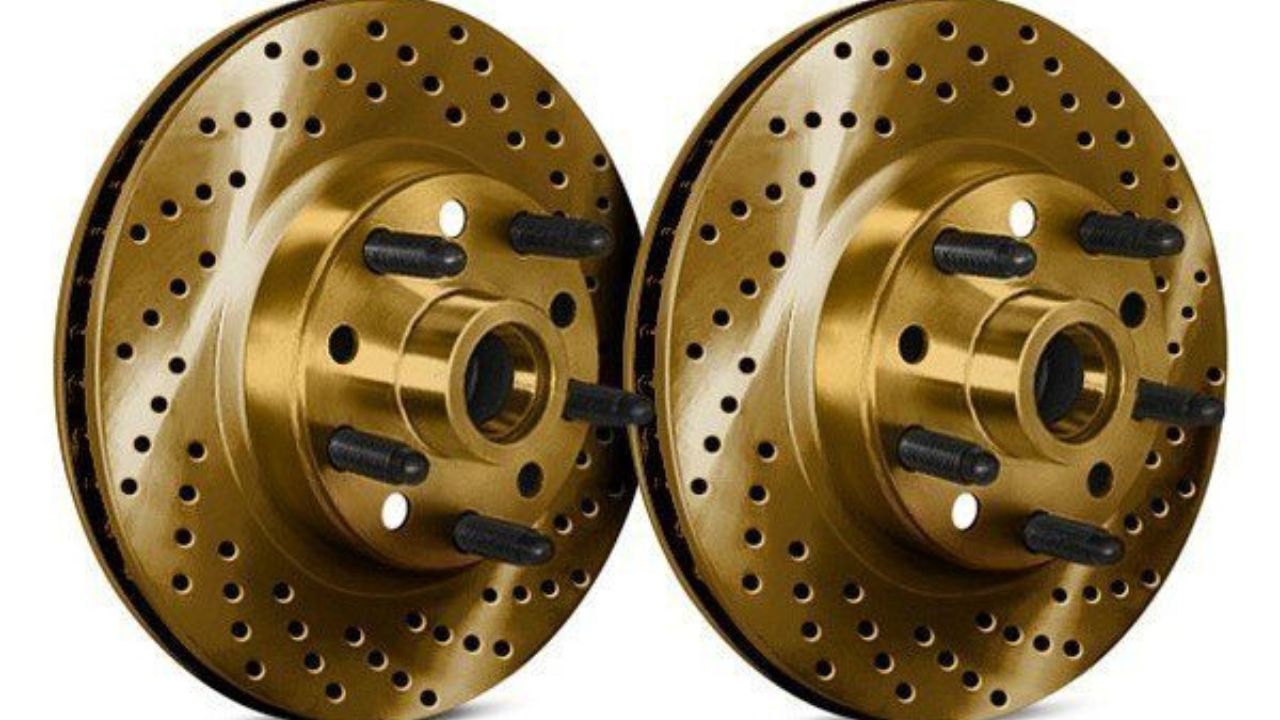
What Are the Benefits of Drilled Rotors for Braking Performance?
Drilled rotors offer several advantages when it comes to braking performance. These rotors’ cross-drilled holes effectively disperse heat, preventing brake fade even after long driving periods. Moreover, these holes prevent the accumulation of gases and debris, keeping the braking surface clean for optimal contact with the brake pad. This results in improved overall braking performance, particularly in wet conditions. Additionally, drilled rotors serve as an appealing upgrade, enhancing the sporty and stylish appearance of your vehicle. Therefore, when seeking to enhance friction and ensure smooth braking, drilled rotors prove to be the superior choice.
Slotted Rotors Comprehension
Slotted rotors, on the other hand, feature narrow slots machined into their surface. These slots serve a similar purpose to drilled holes, facilitating heat dissipation and gas release. Moreover, the slots help to maintain a clean contact surface between the rotor and brake pad, preventing glazing and ensuring consistent braking performance.
Pros of Slotted Rotors:
- Effective heat dissipation.
- Consistent braking performance.
- Reduced risk of glazing.
Cons of Slotted Rotors:
- Possibility of accelerated pad wear.
- Increased susceptibility to debris buildup.
Slotted Rotors: Design and Benefits
On the flip side, slotted rotors are characterized by slots machined in a spiral pattern on their surface. These grooves expose new, gripping material on the pad surface and reduce the buildup of dust and gases at the point of contact between the pads and the rotor. This design feature contributes to enhanced braking performance and prolongs the lifespan of brake pads.
Additionally, slotted rotors regulate rotor surface temperature as the pads wear under typical driving conditions. During wet weather, the etched slots help keep both the rotors and brake pads dry, thereby reducing the vehicle’s wet braking distance.
Comparison Between This Rotors
When comparing this rotor, several factors are considered, including performance, durability, and maintenance requirements. While drilled rotors excel in heat dissipation and wet weather conditions, slotted rotors offer consistent performance and resistance to glazing.
In terms of durability, slotted rotors tend to have a longer lifespan due to their structural integrity, whereas drilled rotors may be more prone to stress fractures over time. However, proper maintenance and usage can mitigate these risks for both types of rotors.
Applications
Drilled rotors are often favored in high-performance vehicles or applications where aggressive braking is common, such as racing or spirited driving. On the other hand, slotted rotors find their niche in daily driving situations, offering reliable performance and longevity.
Considerations for Choosing Between Two Rotors
When deciding between rotors, several factors should be taken into account, including driving habits, environmental conditions, and budget constraints. While drilled rotors may offer superior performance in certain scenarios, slotted rotors provide a more balanced approach for everyday driving.
Cost Comparison
In general, drilled rotors tend to be more expensive than slotted rotors due to the additional machining required. However, the manufacturer and particular application may have an impact on the price differential.
Installation and Maintenance
The installation process for both types of rotors is similar, requiring basic mechanical knowledge and tools. However, it’s essential to follow manufacturer guidelines and torque specifications to ensure proper fitment and performance. In terms of maintenance, regular inspection of the rotors and brake system is recommended to identify any signs of wear or damage promptly.
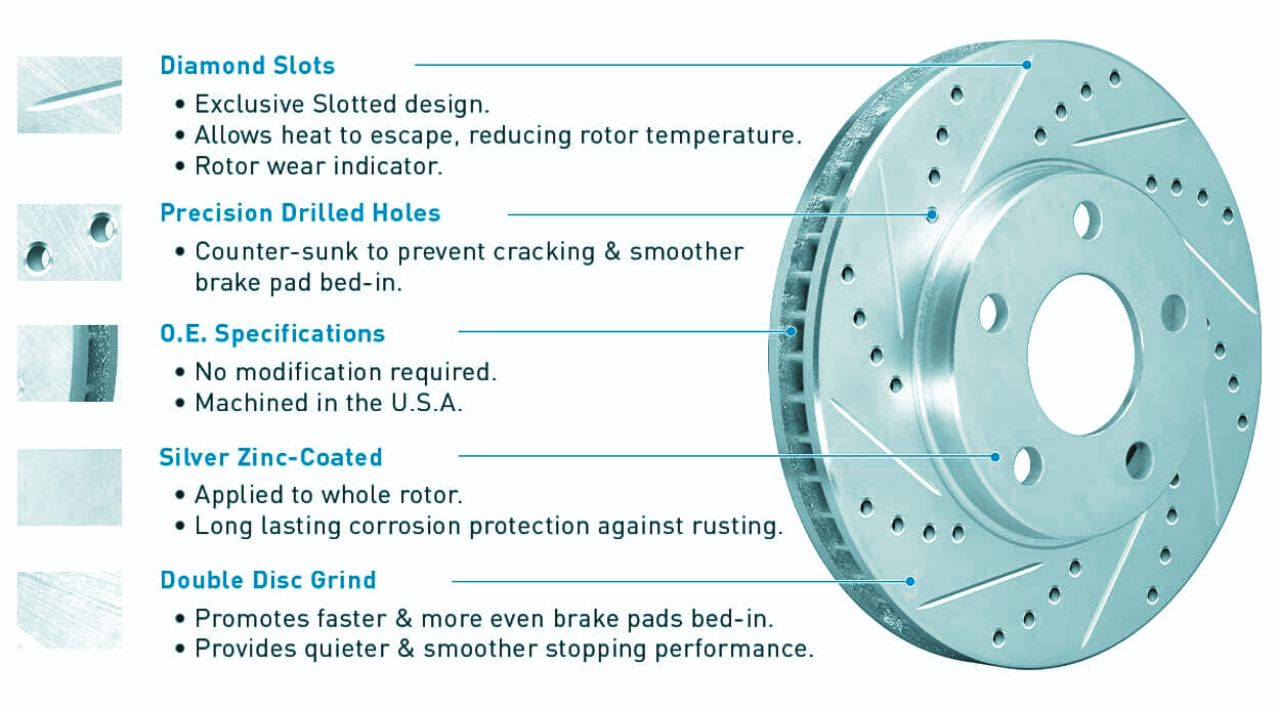
Performance in Different Conditions
Both drilled and slotted rotors perform well under normal driving conditions. However, their true strengths are showcased in extreme situations, such as high-speed braking or inclement weather. While drilled rotors excel in heat dissipation and wet weather performance, slotted rotors offer consistent braking power and resistance to glazing.
Expert Opinions
According to automotive experts, the choice between drilled and slotted rotors ultimately depends on the intended application and driver preferences. While drilled rotors may offer a slight advantage in performance-oriented scenarios, slotted rotors provide a more practical solution for everyday driving.
Real-World Experiences
Many drivers have shared their experiences with both types of rotors, highlighting each’s benefits and drawbacks. Some prefer the aggressive bite of drilled rotors during spirited driving, while others appreciate the consistent braking performance of slotted rotors during daily commutes.
Which is Better?
There’s no conclusive response. When it comes to braking performance, each style of rotor—drilled and slotted—has pros and cons of its own, but both are a big improvement over most factory braking configurations. Slotted rotors excel in high-performance braking scenarios, such as track driving, thanks to enhanced cooling and improved bite. Conversely, drilled rotors are well-suited for everyday street driving, providing superior heat dissipation and mitigating brake fade. Ultimately, your choice of rotor will hinge on your driving requirements and preferences. For further insights into selecting the optimal upgrades for your vehicle, explore our additional features and guides.
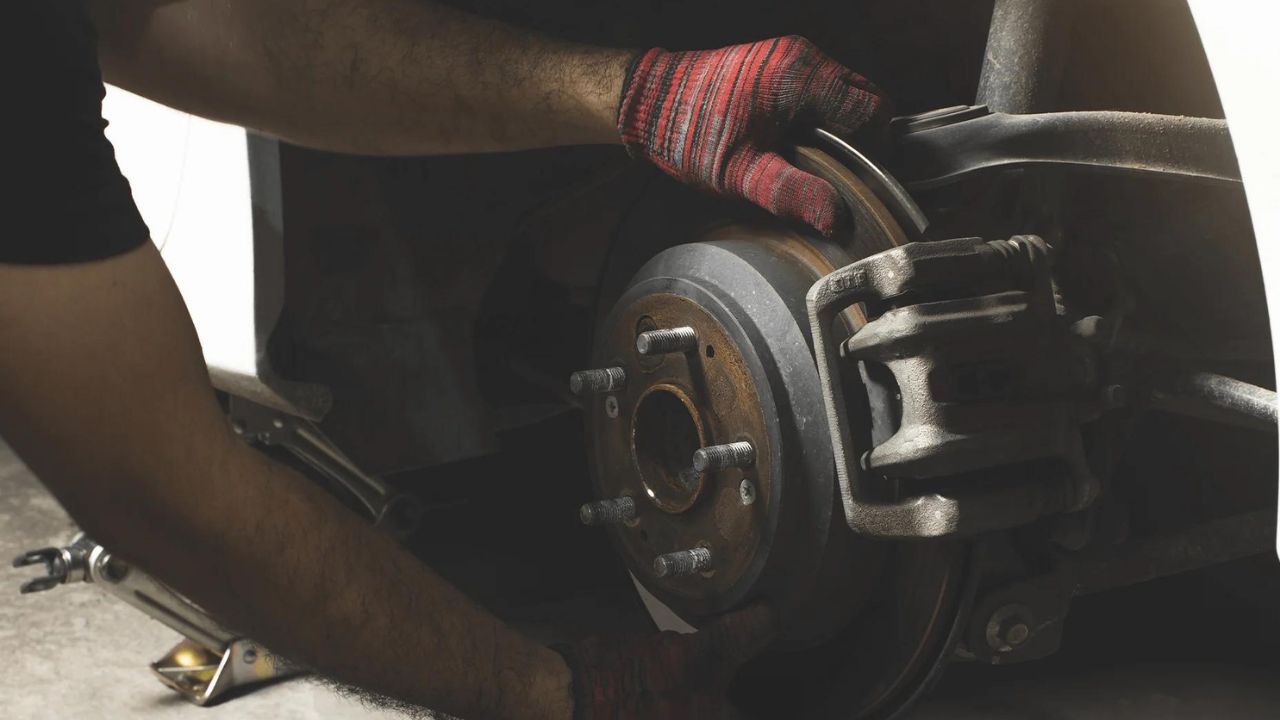
Conclusion
The contrast between drilled and slotted rotors stems from their design and intended uses. Drilled rotors excel at dispersing heat and performing well in wet conditions, whereas slotted rotors deliver steady braking force and resist glazing. They ultimately decide between two hinges: personal driving habits, environmental factors, and budget constraints.
FAQ
Do drilled and slotted rotors impact performance?
Both rotor types enhance braking performance under varying conditions. Drilled rotors keep pads and rotor surfaces free from debris, while slotted rotors excel at dissipating heat and minimizing brake fade.
Do drilled and slotted rotors warp faster?
Opt for cross-drilled rotors or cross-drilled and slotted rotors to mitigate the risk of warped brake rotors. These types of rotors offer improved heat ventilation, effectively reducing rotor temperature and minimizing the likelihood of heat spots forming.
Are drilled and slotted rotors suitable for everyday driving?
Not really. Drilled and slotted rotors do not provide any performance enhancements for daily driving.
How long does it take for drilled and slotted rotors to break in?
Steps for Breaking In New Brake Rotors and Pads
Drive cautiously, typically for the initial 400–500 miles, to properly bed in the brake pads and rotors. Gradually permit the brake pads to establish a layer of friction material on the rotors.
What are the disadvantages of drilled and slotted rotors?
While drilled and slotted brake rotors provide numerous benefits compared to factory rotors (smooth rotors), they also come with some drawbacks.
- Premature Brake Rotor Wear: Occasionally, drilled and slotted disc brakes may experience premature wear.
- Shortened Rotor Lifespan: These rotors may have a shorter lifespan.
- Steering Wheel Vibrations: There’s a possibility of experiencing steering wheel vibrations.
- Inability to Resurface Rotors: This rotor cannot be resurfaced.

